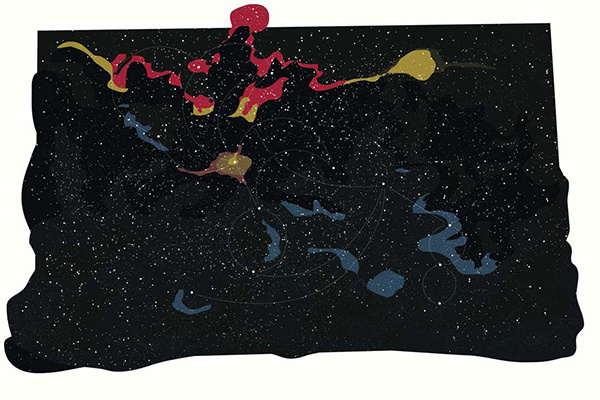
Photo: Courtesy Paul Chan / University of Chicago
Paul Chan's prints are on display alongside emerging artists at the University of Chicago's Booth School of Business.
If you're not familiar with the University of Chicago’s Booth School of Business “hidden gem"—a world-class, private art collection viewable on all six floors of the Harper Center—you're not alone. Few know about the impressive trove of international contemporary art, and even fewer know how the institution amassed it.
I recently met with Dr. Canice Prendergast, professor of economics and keeper of the collection, who gave me a tour and revealed how the highly active art-collecting school operates. With a team of four curators and collectors, each year Prendergast adds ten to fifteen artworks to the collection, which currently numbers nearly 500 pieces by 86 artists. With a healthy budget for art, the business school now has a significant profile among international dealers, who want to get their artists into the prestigious collection.
The committee of five art experts has an unofficial rule: paintings must be seen in the flesh before they can be purchased (whereas photography can be approved from online images). Since two of the committee’s members live in Los Angeles (Suzanne Deal Booth and Dean Valentine), the group often meets at art fairs like Art Basel Miami, Frieze in New York, or Expo in Chicago to view a possible additions to the collection. Four of the five committee members must vote to approve a purchase.
The committee is rounded out by two high-profile Chicago-based curators, James Rondeau of the Art Institute and Suzanne Ghez, outgoing director of the Renaissance Society. (Service on the Booth’s art committee is a life-long committment) Having these high-profile curators on board boosts the committee’s buying power. In the art world, a lot of cash is not enough to purchase work by a famous artist; prestige counts just as much, if not more, than cash. The influence of Rondeau and Ghez, as well as the collection’s now-prominent profile, are attractive for major art world figures like Wolfgang Tillmans. The Booth’s art committee commissioned Tillmans to install four walls of his photographs on the school’s lower level. One photo in the installation shows the artist Felix Gonzalez Torres wearing a Chicago Police Department jacket. The jacket of the deceased artist now lives in Suzanne Ghez’s closet.
A dozen or more of the collected artworks made their way into the Booth’s collection after first passing through the AIC or the Ren. Artworks that don’t get accepted into the AIC through their donor group (called the Society for Contemporary Art) often end up at the Booth, and a few artists who have shown at the nearby Ren (which exhibits art but does not buy any) have been purchased by the business school. Professor Prendergast is on the board of the Ren and a member of the art acquisition group of the Society of Contemporary Art at the AIC.
Super famous artists mingle young, emerging artists in the collection. There are works by Jeff Wall and Paul Chan alongside Valerie Snobeck (a U of C grad), Sanya Kantarovsky, and Anna Boghiguian. The younger artists are “relatively unknown,” says Prendergast, although these artists do show internationally and are on the radars of many curators. Still, art lovers have few opportunities to view work by these young artists in Chicago, and the Booth’s collection is great exposure.
How does an artist get on the radar of the committee? “I’ll look at anything,” says Prendergast of the many emailed images he gets from dealers and artists. In the end, the committee has no agenda except to collect art that is international in scope. “We trust our instincts,” says Prendergast, and they have “an enormous amount of free reign from the school.”
After seven years of collecting, the personality or taste of the committee has become apparent. Clearly they adore abstract painting and drawing—it makes up a majority of the holdings—as well as photography with a documentary feel. The committee noticed an unintentional bias for contemporary German painting in their collecting habits, so they’ve self-mandated, says Prendergast, “to look more carefully at more underrepresented areas,” like Egypt, Scotland, the Middle East, and even Chicago.
Of the nearly 500 works on view, just two are sculptures. A barren tree with boulders lodged in its branches is actually a thirty-ton bronze artwork by the Italian sculptor Giuseppe Penone. The committee searched five years for a perfect outdoor sculpture until they saw Penone’s boulder-tree on view at Documenta, a major international exhibition in Germany, last year, and now the tree has a permanent home on the Booth School’s lawn. Penone’s tree makes a striking complement to the AIC’s massive carved tree by Charles Ray on permanent view in the Modern Wing.
The Booth’s art collecting program has been so successful that other colleges in the University are exploring starting their own art collection, such as the medical school. The art collection is fully cataloged on a special website (art.chicagobooth.edu


